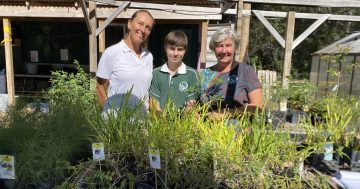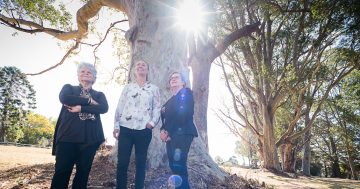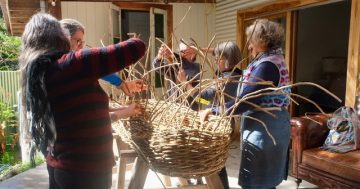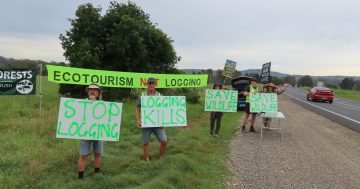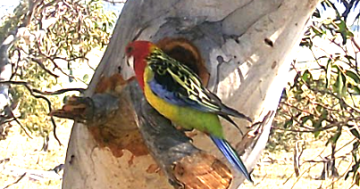
Narooma High School Year 10 student Tarly with Walawaani Way founder Fiona McCuaig and science teacher Christina Potts. Photos: Marion Williams.
Two years ago, Narooma High students collected seeds from around the school and nearby Mystery Bay. Last week, six students went to natural conservation burial ground Walawaani Way to plant 60 of the 500 small native plants they grew from those seeds specifically for the site.
They were planting black she-oak (Allocasuarina littoralis). Its seeds are a favourite food of the vulnerable glossy black cockatoo.
Narooma High science teacher Christina Potts said the plants would also provide habitat for small birds.
“Small birds won’t cross this expanse, so planting these trees will allow small birds and animals to traverse the landscape from one creek to the next,” she said.
The Year 9 and 10 students dug holes four metres apart to put the plants in and erected biodegradable cardboard tree guards to create a microclimate and shelter them from wind on the elevated site. After watering and mulching, they installed metal Ekidna tree guards for protection from kangaroos and wallabies.
Eventually, there will be smaller plants between the black she-oaks to attract different species of animals and birds.

Narooma High School Year 9 students Brody Crawford, Ryan Tague and Mac Sunderland spent an hour digging holes for the plants.
Ms Potts said earlier that day the six young volunteers had been in the school’s garden shed dancing and singing because they were so happy.
“They love coming out on things like this,” she said.
Walawaani Way founder Fiona McCuaig said planting trees was good for children’s mental health.
“It is doing something good for the environment when they hear so much about climate change,” Ms McCuaig said.
She was grateful for the children’s help given the huge reforestation and conservation project now underway and hopes other schools and groups will become involved.
Around two-thirds of the 18-hectare site is established bushland, but the other third had been cleared for agricultural use. This section will be the burial site. It will eventually be planted with trees, and Ms McCuaig intends replacing the kikuya with wallaby and kangaroo grasses.
All the plants are endemic to the south-east sclerophyll forest. The whole idea is biodiversity. That includes the 120 trees planted by the Eurobodalla Koala Project to establish a corridor on the site for koalas.
“It is a bit of an investment, taking the time to get it right,” Ms McCuaig said. “They need to be looked after intensely for the first three months, watering every week, and really up to two to three years, you have to keep watering, just as we did with the koala trees.”

One of the hollow-bearing old trees on Walawaani Way’s 18-hectare conservation site in Bodalla.
The old highway runs through the site, and Ms McCuaig has bought an easement from Eurobodalla Shire Council. She must upgrade the road and maintain it in perpetuity.
“I am very grateful council has allowed me to use it because it is so beautiful,” she said.
It includes an ecologically sensitive wetland that she and her husband, Ben Stainer, are beginning to regenerate by planting eucalypts for shade.
She has visions of mourners carrying their loved one along the road.
“It is based on Clandon Wood in the UK, where they have horse-drawn carriages,” Ms McCuaig said. “It is slowing it down to how we used to do it.”
A ceremony building is also on the cards, although she wants to minimise man-made structures on the site.
Ms McCuaig said burying people in a shroud made from cotton, linen or hemp was the fastest and most graceful way for the body to return to the elements of the soil.
“Having bodies on a beautiful piece of land is the best way to protect the forest and people want to do something good with their body as their last act,” Ms McCuaig said.
“Some people just burst into tears because they are so relieved their final resting place will be in such a beautiful place. It isn’t morbid. I can’t believe how much happiness it has brought to people because it’s such a positive end-of-life decision.”
Walawaani Way is Australia’s first 100 per cent natural conservation burial site where people can finally be laid to rest back into a conservation initiative.
The first Workshop Weekend will be held on 25 and 26 October. Renowned Byron Bay artist Zimmi Forest will teach people how to weave a biodegradable coffin out of the invasive cat’s claw vine. Another artist, Michele Elliot, will conduct shroud-making classes. It is all part of bringing people together and talking about ”doing death better”.







